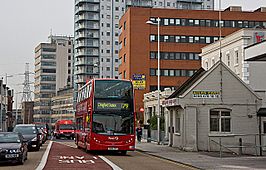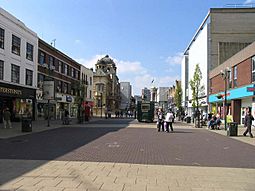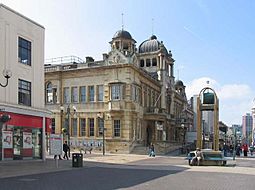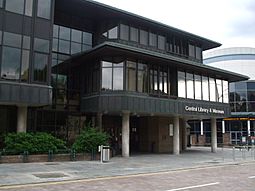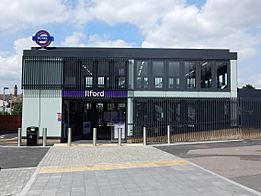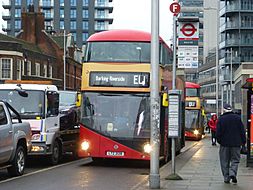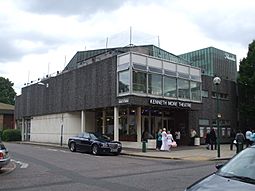Ilford facts for kids
Quick facts for kids Ilford |
|
|---|---|
|
From top to bottom: Redbridge Town Hall on Ilford High Road; Ilford Hill
|
|
| Population | 168,168 (2011 Census) |
| OS grid reference | TQ445865 |
| • Charing Cross | 9.0 mi (14.5 km) WSW |
| London borough | |
| Ceremonial county | Greater London |
| Region | |
| Country | England |
| Sovereign state | United Kingdom |
| Post town | ILFORD |
| Postcode district | IG1-IG6 |
| Dialling code | 020 |
| Police | Metropolitan |
| Fire | London |
| Ambulance | London |
| EU Parliament | Greater London |
| UK Parliament |
|
| London Assembly |
|
Ilford is a large town in East London, England. It is about 9 miles (14 km) northeast of Charing Cross, a famous spot in central London. Ilford is part of the London Borough of Redbridge and had about 168,168 people living there in 2011.
Ilford is a busy centre for shops and businesses. It is surrounded by many homes. The town is on an important route between London and Essex, with the A12 and the main train station connecting these areas. In recent years, many people from different countries have moved to Ilford, making it a very multicultural town.
Long ago, Ilford was a small village in Essex. It was located on the River Roding and the main road from London to Colchester. This made it a popular stop for coaches. When the railway arrived in 1839, Ilford grew much faster. It became part of the larger London area. In 1965, Ilford joined with nearby towns to form the London Borough of Redbridge. This new borough became part of Greater London.
Contents
About Ilford's Name and History
What Does "Ilford" Mean?
Ilford was once called Great Ilford to tell it apart from nearby Little Ilford. The name "Ilford" first appeared in the Domesday Book in 1086. It means "ford over the Hyle." "Hyle" was an old Celtic name for the River Roding, meaning "trickling stream." Both Great and Little Ilford got their names from this river crossing.
How Ilford Became a Town
For a long time, Ilford was part of a huge land area called the Manor of Barking. This manor was first mentioned in 735 AD. Later, it became part of the ancient parish of Barking.
The Parish of Barking was very large, covering areas now known as Barking and Ilford. In the 1800s, Ilford slowly started to manage its own affairs. In 1888, Ilford officially separated from Barking. It formed its own local council. In 1926, Ilford became a "municipal borough," which meant it had its own town government.
Joining the London Borough of Redbridge
In 1965, Ilford's borough government was ended. Its area joined with Wanstead and Woodford and parts of other nearby places. Together, they formed the new London Borough of Redbridge. This new borough became part of Greater London.
Who Represents Ilford?
Ilford is split into two areas for the UK Parliament: Ilford North and Ilford South. Each area elects a Member of Parliament (MP) to represent them in the government. Currently, Wes Streeting is the MP for Ilford North, and Sam Tarry is the MP for Ilford South. Both are from the Labour Party.
Ilford Through Time
Ancient Discoveries
In 1864, a complete skull of a mammoth was found near Uphall Road in Ilford. This is the only complete mammoth skull ever found in the UK! You can see it at the Natural History Museum. A copy of the skull is at the Redbridge Museum in Ilford.
The oldest signs of people living in Ilford are from the Iron Age, around 100-200 BC. These are earthworks called Uphall Camp. Roman objects have also been found nearby.
How Ilford Grew as a Town
Ilford was on a key road from London to Colchester. The River Roding was made suitable for barges in 1737. This helped transport goods. Ilford was mostly a countryside area until the 1800s. Then, it started to grow quickly. Brickworks, cement works, and coal yards opened to support the new buildings.
In 1839, a train station opened. This made it easier for people to travel to London. New businesses like paper making and laundries started up. These served the people who now lived in Ilford and commuted to work.
Many important companies started in Ilford. One famous one is Ilford Photo, which makes photographic film and chemicals. It was started in 1879 by Alfred H. Harman. The company grew very big in Ilford before moving its factory in 1976. You can see many Ilford Limited products at the Redbridge Museum.
Another big company was Plessey, which made electronics and telecommunications equipment. During World War II, part of their factory was bombed. So, they moved some production into the underground railway tunnels between Wanstead and Gants Hill. By 1955, Plessey employed 15,000 people in Ilford.
Today, The Exchange is the main shopping centre in Ilford.
Ilford's Population Growth
By 1653, Ilford was a small village with about 50 houses. In 1801, its population was 1,724. By 1901, it had grown to 41,244 people. From 1921, many new homes were built as part of the huge Becontree Estate. This caused Ilford's population to rise even more.
The Central line of the London Underground arrived in 1947. This made it even easier to travel to London. Ilford's population reached its highest in 1951 with 184,706 people.
Important Moments
John Logie Baird, who invented the television, worked in Ilford in the 1920s. He had a workshop on the roof of the Plessey building.
The famous actor Maggie Smith was born in Ilford.
During World War II, an Ilford man died when his Royal Air Force training plane crashed in the United States. Local people in Oklahoma built a monument in 2000 to remember him and three other RAF fliers. The Mayor of Redbridge even attended the event.
Because it was close to the Olympic Park in Stratford, Ilford became a fast-growing tourist spot in Europe in 2011, thanks to the London 2012 Summer Olympics.
Ilford's Economy
Ilford is an important shopping area in London. In 2005, it was ranked sixth for retail (shopping) in Greater London. This means it has a lot of shops and businesses. As of 2020, Ilford has a large amount of shopping space, making it one of the top ten busiest town centres in Greater London.
Ilford's Location
Ilford is bordered by the North Circular Road and the River Roding to the west. To the east are Chadwell Heath and Romford. To the south is Barking. The Alders Brook river forms part of the boundary between Newham and Redbridge.
People of Ilford
Population Numbers
| 1891 | 10,913 |
|---|---|
| 1901 | 41,234 |
| 1911 | 78,188 |
| 1921 | 85,194 |
| 1931 | 131,061 |
| 1941 | # |
| 1951 | 184,706 |
| 1961 | 178,024 |
| # no census was held due to war | |
| source: UK census | |
The town of Ilford includes several neighbourhoods like Barkingside, Gants Hill, and Goodmayes. In the 2011 census, the total population of Ilford was 168,168 people. This is about half the population of the entire Redbridge borough.
Different Cultures in Ilford
Ilford has a very diverse population, meaning people from many different backgrounds live there. It is one of the most multicultural towns in the UK.
Many people in Ilford are from South Asia. They speak languages like Bengali, Gujarati, Hindi, Punjabi, Tamil, Telugu, and Urdu.
According to the 2011 census, one area called Clementswood had 84.2% of its population from a Black, Asian, or minority ethnic (BAME) background. This is one of the highest numbers in Greater London. Most other areas in Ilford also have high diversity.
Homes in Ilford
House prices in Ilford are generally lower than the average for Greater London. In 2014, the average house price in Ilford's Loxford area was £193,000. This was one of the lowest in Greater London.
In most parts of Ilford, most homes are owned by the people who live in them.
Getting Around Ilford
Trains and Underground
Ilford railway station is on the main train line from London. It is served by Elizabeth line trains. You can also catch these trains at nearby Seven Kings and Goodmayes stations.
Ilford also has a special depot for maintaining electric trains.
The London Underground's Central line runs north of Ilford. Stations like Redbridge, Gants Hill, and Newbury Park are close by. These stations connect Ilford directly to Stratford, the City, and the West End of London.
Buses
London Buses connect Ilford to other areas in east and central London. Many bus routes serve the town, including night buses.
The East London Transit route EL1 starts in Ilford. It connects to other routes that go to places like Chadwell Heath and Dagenham.
Roads
Ilford is a key road destination in east London. Main roads connect the town to important places across London and the East of England.
The A118 runs through Ilford, linking it to Stratford to the west and Romford to the east. The A123 goes north and south, connecting to Gants Hill and Chigwell to the north, and Barking to the south.
The A406 North Circular Road links Ilford to north and west London. It also connects to the M11 for Stansted Airport and Cambridge.
North of Ilford, the A12 connects to the M25 and towns like Chelmsford and Ipswich.
Cycling
There are cycle lanes along the A118 that go between Stratford, Ilford, and Romford.
Cycle Superhighway 2 starts in Stratford and goes through Mile End to the City. This route is mostly separate from other road traffic.
Cycleway 16 passes north of Ilford. It provides a direct cycle path between the Queen Elizabeth Olympic Park at Stratford and Barkingside.
The Roding Valley Way is a path for both cyclists and walkers. It runs next to the River Roding and starts in Ilford.
Famous Places in Ilford
Valentines Mansion was built in 1696. It is a historic house that gives its name to Valentines Park. This park is the biggest green space in the borough.
Pioneer Point is made of two tall buildings. Pioneer Point North is 105 metres (344 feet) tall with 33 floors. Pioneer Point South is 82 metres (269 feet) tall with 25 floors.
Raphael House is 99 metres (325 feet) tall, and Lynton House is 93 metres (305 feet) tall. Both were finished in 1969.
Places of Worship
St Mary's Church is the original church of the area. Ilford Hospital Chapel is the oldest building in Redbridge, built around 1140.
There are also many other places of worship for different faiths, including Muslim, Hindu, and Sikh buildings.
Schools in Ilford
Loxford School in Loxford is a large school with over 3,000 students aged 11 to 18. Seven Kings School is also a big school. The Palmer Catholic Academy and Ursuline Academy Ilford are Catholic secondary schools. Uphall Primary School is a primary school in Loxford.
Culture and Fun in Ilford
Arts and Entertainment
The local newspaper for Ilford and the borough is the Ilford Recorder.
The Kenneth More Theatre opened in 1975. It puts on many different shows, both professional and amateur. It is well known for its yearly pantomime, a fun show for families around Christmas.
St. Alban's Singers is a choir based at St. Alban's Church. They practice every week and perform concerts three times a year.
The singer Kathy Kirby was born in Ilford.
Sports
Ilford Cricket Club plays its home games at Valentines Park. This ground opened in 1897.
Two football clubs, Ilford F.C. and Barkingside F.C., play at the Cricklefield Stadium.
South Park is one of the largest open spaces in the London Borough of Redbridge. It has won a Green Flag Award, which means it is a well-managed park.
|
See also
 In Spanish: Ilford para niños
In Spanish: Ilford para niños



